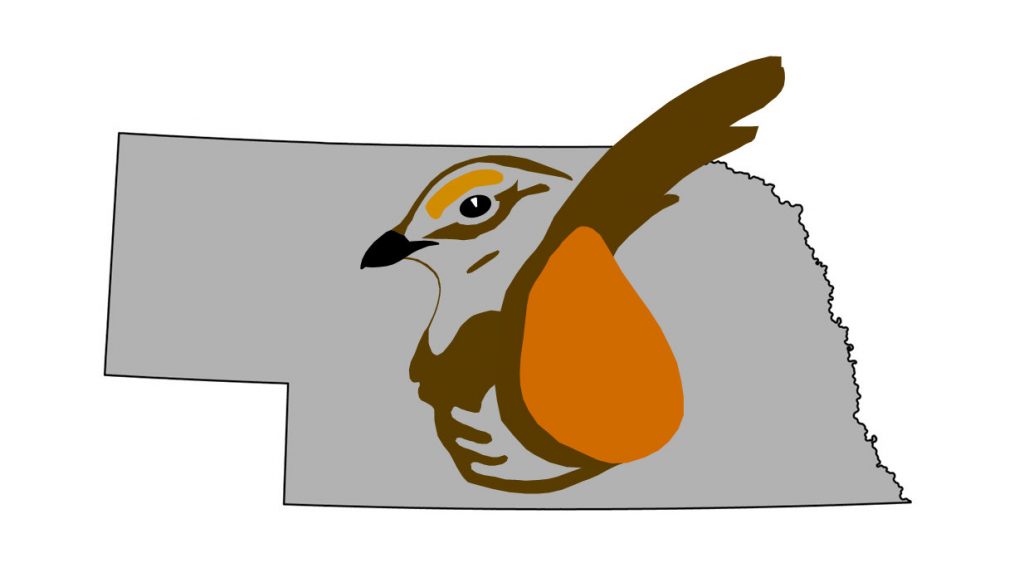By September 2024, Nebraska had an official state bird list that includes 469 species (Brogie 2024). Of this total, approximately 350 occur annually and about 200 regularly breed in the state. In addition to this total of accepted species, there are others that have been unsuccessfully introduced, unacceptably documented, or species whose origin was in question, as well as hybrids. In all, the Birds of Nebraska — Online includes 683 individual species accounts, 69 of which deal with hybrids reported in the state. These species accounts generally follow the format used by Sharpe et al (2001) and readers are referred to that work for in-depth introductory sections on Nebraska’s physical environment, biological communities, and history of ornithology. In addition to what is found in Sharpe et al (2001), we provide below a brief overview of our study area, Nebraska, as well as information supplemental to Sharpe et al (2001) that has become available since that volume was published. Finally, we provide a page on “How to Use” species accounts page that describes the format and style conventions of the species accounts included in Birds of Nebraska — Online.
Setting
Nebraska is located near the geographic center of North America and totals 200,365 square kilometers (77,358 square miles) and is divided into 93 counties (Figure 1). The human population totals 1.8 million as of the 2010 census (U.S. Census 2017), and resides primarily in the east, especially in the state’s largest cities of Omaha and Lincoln. Large portions of the north-central part of the state do not have any cities > 5,000 residents (Figure 2).
Nebraska generally slopes gently downhill from west to east (Figure 3), with the state’s lowest elevation, less than 260 meters (850 feet) above sea level, located in the far southeast tip in Richardson County (Condra 1906). The highest elevation of more than 1,615 meters (5300 feet) above sea level is found in southwest Kimball County near the Colorado and Wyoming borders (Condra 1906). As a result of the general slope, Nebraska is drained from west to east by several major mid-continental rivers that include the Niobrara, Platte, Republican, and their tributaries, and portions of other rivers such as the Little Blue, Big Blue, Big Nemaha, and Little Nemaha (Figure 4, 5). All rivers found in Nebraska eventually drain into the Missouri River, which also defines the state’s eastern boundary with Iowa, Missouri, and South Dakota.
Historically, the overwhelming majority of the landscape of Nebraska was prairie (Figure 6). Tallgrass prairie covered about the eastern third of the state and transitioned to mixed-grass prairie in central Nebraska and eventually gave way to shortgrass prairie in the west (Schneider et al 2011). Relatively small areas of oak-hickory and riparian forests were present primarily in the east, especially along river and stream corridors. In the west, pine woodland and savannah were found on escarpments in the Panhandle. In the middle portion of the Niobrara River, a mixing of eastern, western, and remnant northern ecological communities is present as a result of long-term climate shifts over millennia (Schneider et al 2011).
Nebraska’s contemporary vegetation is both different and unchanged from what was present historically (Figure 7). Large areas with soils and topography favorable to row crop agriculture have been converted, especially in the east and south-central where corn and soybean production dominates the landscape in areas that were formerly tallgrass and mixed-grass prairie. Agricultural development has also greatly altered many of the riverine and aquatic systems in the state (Archer et al 2017). Many wetlands were drained or filled to prevent flooding of crops (LaGrange 2005). In other areas, river flows were diverted and reservoirs and canals were created to store and deliver water needed to sustain crops during growing seasons.
Areas of the state not compatible with row–crop agriculture, either because of poor soils, steep topography, or both, retain much of their native vegetative communities. For example, the Sandhills of north-central Nebraska remain largely intact. Upland oak-hickory forest is still present in areas of the east were it occurred historically, but in some areas, especially near large cities such as Omaha and Bellevue, it is fragmented due to residential development. Escarpments in the west also retain vegetation communities similar to what was present historically. However, lack of fire for decades has resulted in overly dense stands of pines and cedars in many areas and, more recently, catastrophic fires have burned large tracts.
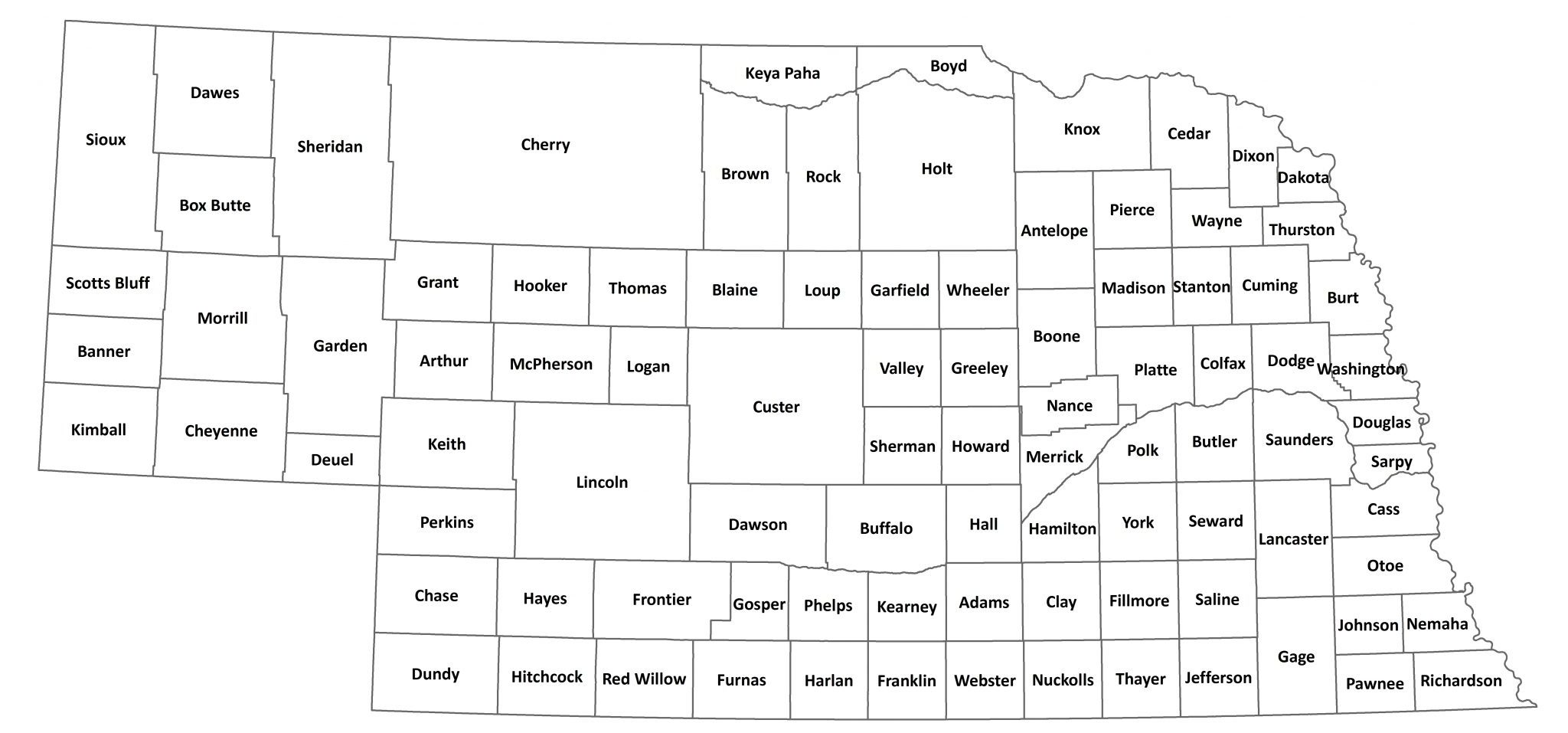
Figure 1. Nebraska’s Counties.
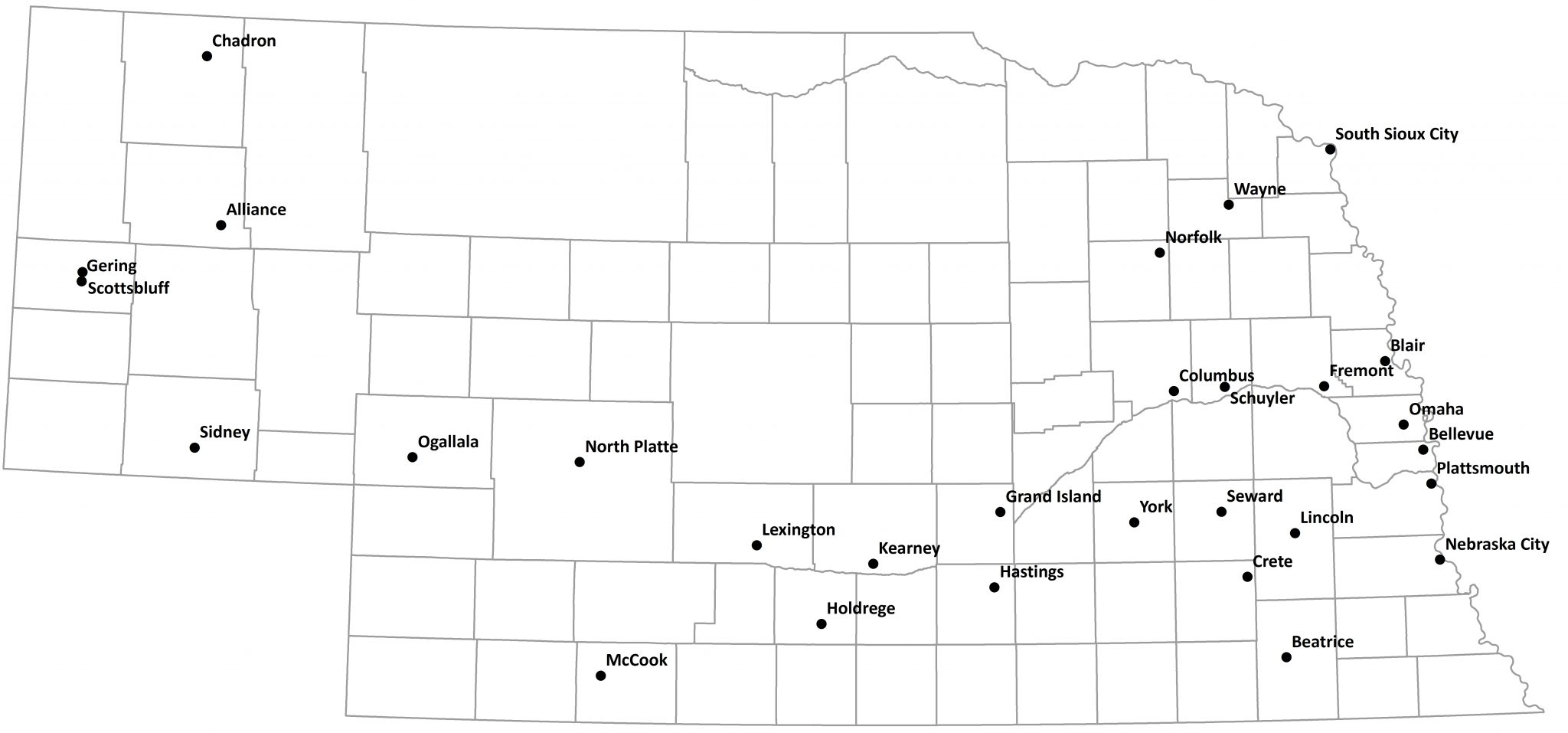 Figure 2. Spatial distribution of cities with > 5,000 residents in 2010.
Figure 2. Spatial distribution of cities with > 5,000 residents in 2010.
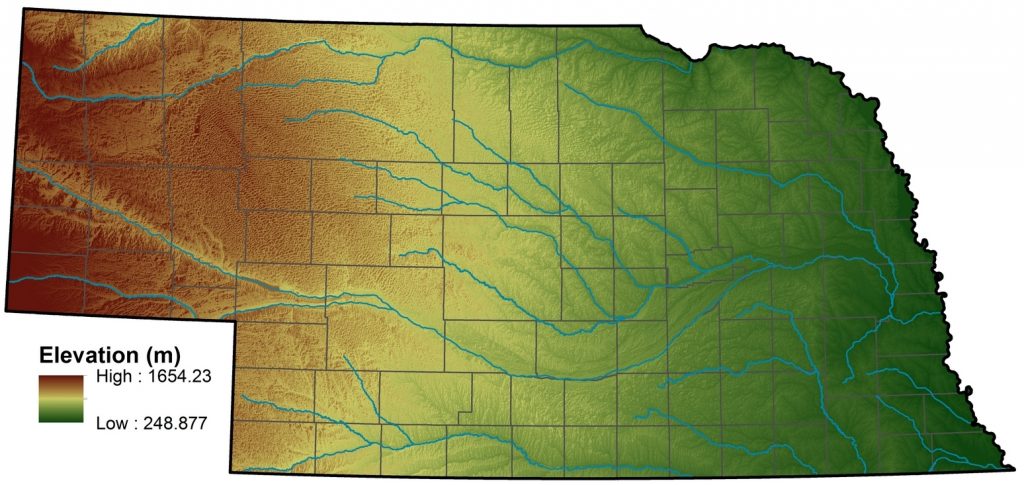
Figure 3. Elevational relief of Nebraska. Lowest elevations above sea level are in the southeast and are colored dark green. Highest elevations above sea level are in the west and are colored dark red.
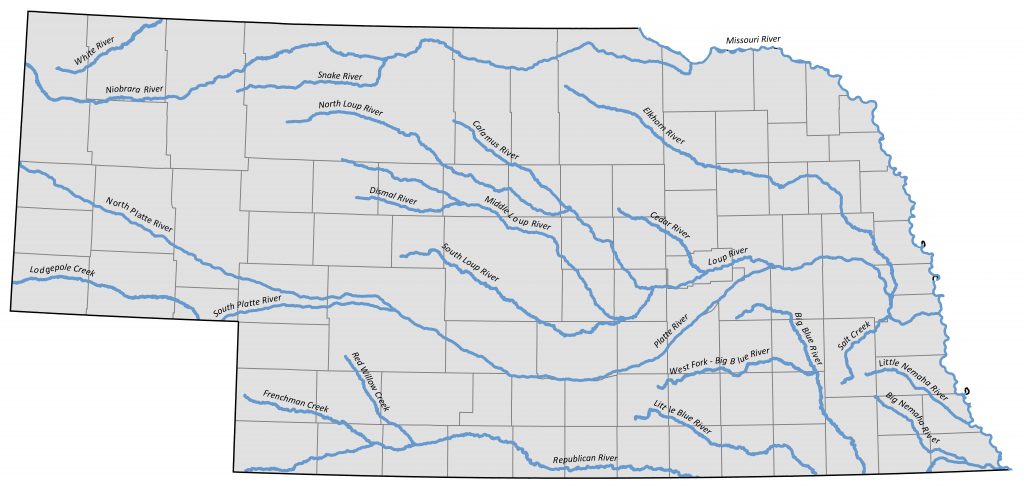 Figure 4. Rivers and major streams of Nebraska.
Figure 4. Rivers and major streams of Nebraska.
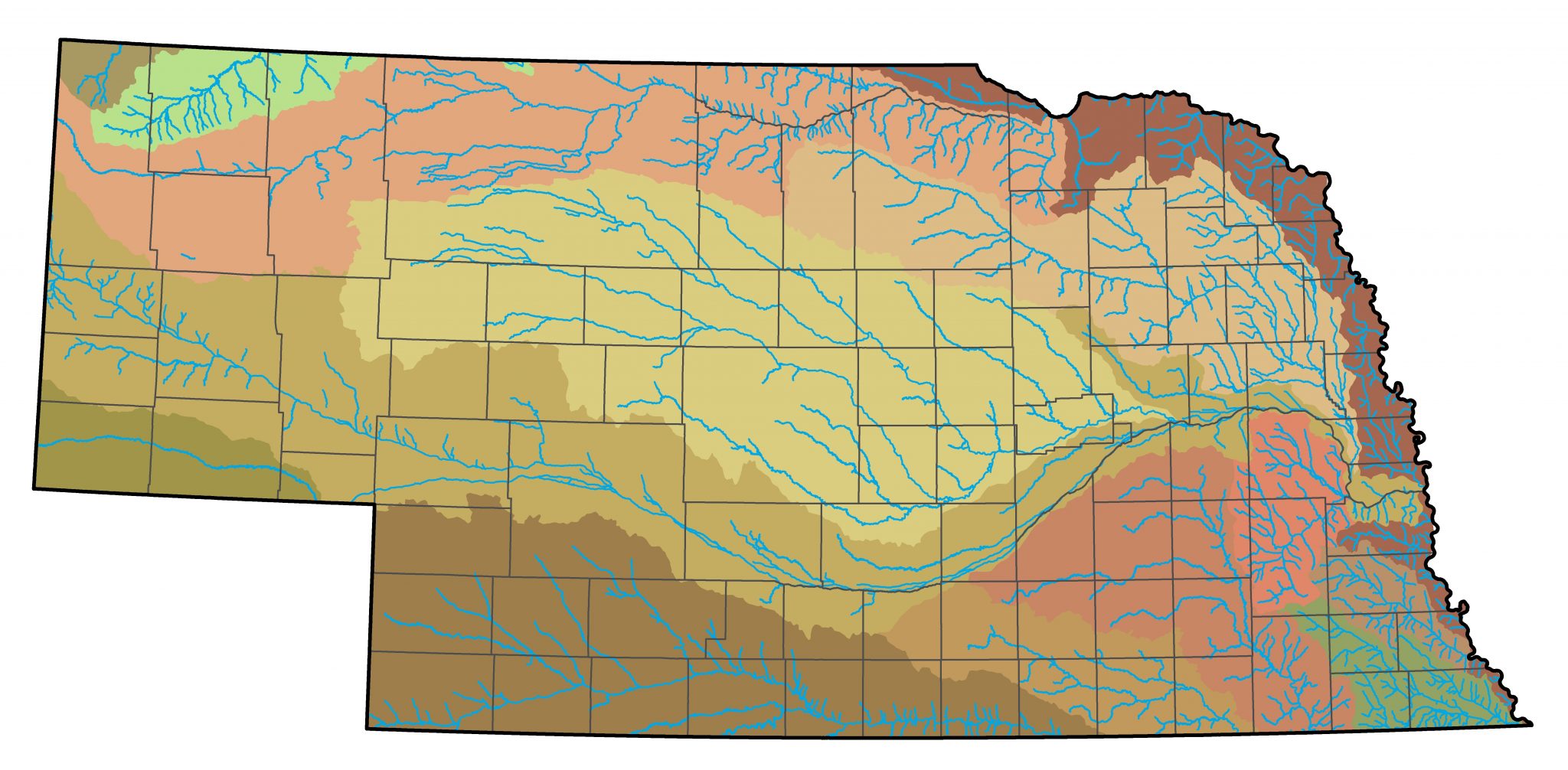
Figures 5. River and major stream drainages of Nebraska. Different colors represent different drainages. Names of river and major stream drainages can be found in Figure 4.
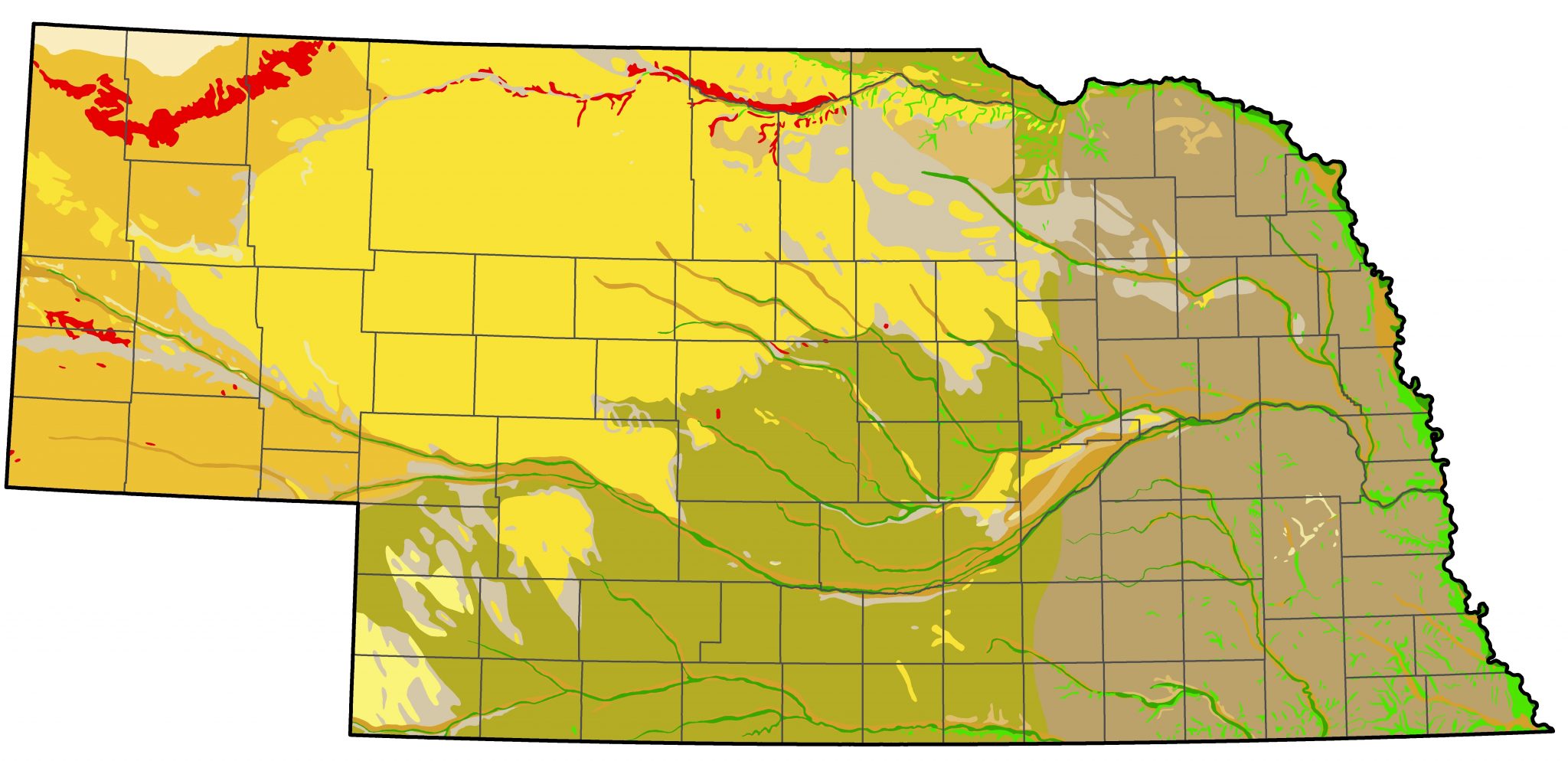

Figure 6. Native vegetation of Nebraska. Map based on data from Kaul and Rolfsmeier (1983) and used with permission from R. Kaul, University of Nebraska, and Les Howard, Conservation and Survey Division, University of Nebraska.
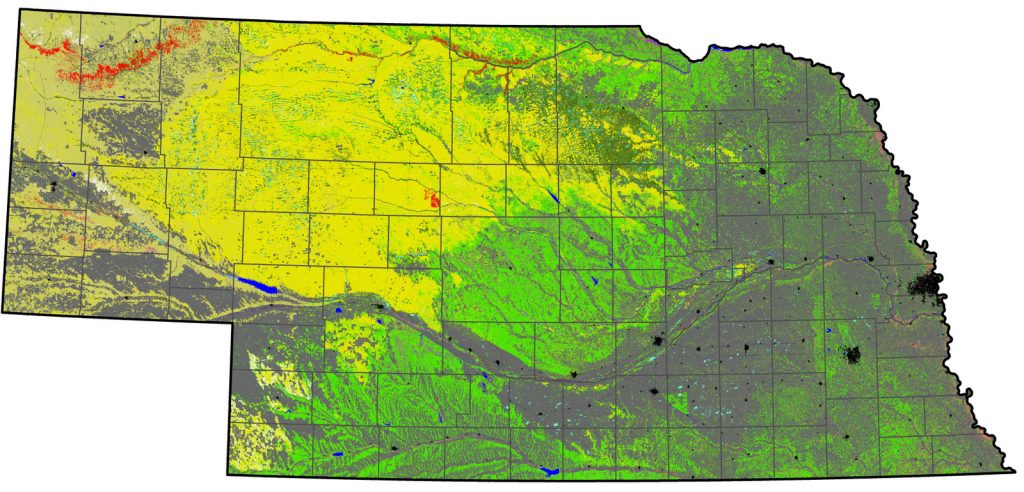

Figure 7. Contemporary land-use and/or vegetation of Nebraska. Map based on 2005 Gap Analysis Program (GAP) of the U.S. Geological Survey.
History of Nebraska Ornithology
Here, we add the following sections on W. Edgar Taylor and Daniel H. Talbot to the biographies included in “Late University Period: 1860-1915” (see Sharpe et al 2001).
W. Edgar Taylor
Little appears to be known about W. Edgar Taylor, who was a Professor of Natural History and Geology at Nebraska State Normal School, now Peru State College, at Peru, Nebraska, for at least four years around 1892. Professor Taylor produced the first annotated list of the birds of Nebraska (Taylor 1888). Oddly, the only citation of this list by subsequent authors, notably Bruner et al (1904), was that of Wolcott (1902) in a bibliography of Nebraska ornithology. In a review of this paper published in The Auk, James A. Allen (1889) noted that “the author states that the list is based, in addition to his own “comparatively meagre” observations, upon every source of reliable information, published or unpublished, open to him, including records published in Baird’s ‘Birds of North America,’ Dr. Aughey’s ‘Locust Feeding Birds,’ and the records and collections of the Normal Science Society, and of various personal friends. The list is briefly annotated, and is apparently very carefully compiled”; it contained “no improbable records”. Allen also noted that “A number of western forms of eastern species which are unquestionably common in the western part of the State are omitted”; as stated by Taylor, at the time knowledge of these western taxa in Nebraska was limited. Taylor and an associate, A.H. Van Vleet, in 1888, began a series of three articles in Ornithologist and Oologist entitled “Notes on Nebraska Birds” (Taylor and Van Vleet 1888a, 1888b, 1889). The authors stated: “The only published records made on the birds of Nebraska are found in “Birds of North America,” Vol. I, 1856, by Baird, Cassin and Lawrence; also in Annual Report of United States Entomological Commission, 1877, is an article by Dr. Samuel Aughey, entitled, “Aughey on Locust Feeding Birds.” These records are very unsatisfactory and incomplete, as well as somewhat out of date, being classified under the old nomenclature. In the articles now published, we have endeavored, by freely using information from every source, to bring up the past records, as well as add additional notes made by ourselves or reliable parties. When a species is well known and generally distributed, no mention is made of the various references, but when the species is thought to be rare, or only mentioned by one or two, the authorities are quoted.”
Daniel H. Talbot
There is an extensive collection of Nebraska specimens collected by D.H. Talbot in the University of Iowa Museum of Natural History (www.vertnet.org, accessed November 2017). Prominent among these are grassland birds, including many specimens of Lapland and Chestnut-collared Longspurs, American Tree, Vesper, Savannah, and Song sparrows, Bobolink, Western Meadowlark, Red-winged Blackbird, and Dickcissel. Although most of these 1000+ specimens were collected in 1884, predating the earliest specimens at the University of Nebraska State Museum, we only cite as voucher specimens those from the Talbot Collection that add to knowledge of Nebraska birds.
Also, we make the following updates to Sharpe et al (2001) involving “The Swenk years, 1900-1940”, and “Recent Ornithology”.
The Swenk years, 1900-1940
A. M. Brooking was a very popular museum director and had a strong following in the Hastings area. One outgrowth of this relationship was the development of the Hastings (later Brooking) Bird Club, which remained very active many years after Brooking’s death. One of the results of Brooking’s influence was the development of an excellent representative collection of the birds of Nebraska at the Hastings Museum. Several significant specimens either reside in that collection or were once part of that collection.
Unfortunately, doubts have arisen in recent years about the validity of some of the significant specimens in the Hastings Museum collection. We have dealt with these cases in the relevant Species Accounts. These doubts concern a major contributor of specimens to the Brooking collection, Cyrus A. (Cy) Black of Kearney, a sportsman, hunter, and professional taxidermist, and his association with Miles Maryott of Oshkosh. Black and Maryott not only collected several quite rare specimens, but also some which subsequently have proved unique for Nebraska. Black provided taxidermy services to the Hastings Museum, and presumably had access to the accession and labelling procedures. It has been alleged by a long-time member of the Nebraska Ornithologists’ Union (NOU), John Plank of Council Bluffs, IA, now deceased, that Black, or Black and Brooking in collusion, “created” some Nebraska records by obtaining specimens from elsewhere and claiming that they were of Nebraska origin. Plank, in personal discussions with Roger Sharpe, related that he learned of these activities from Black who was his mentor while growing up in Kearney (see, for example, species account on Lesser Prairie-Chicken).
Recent Ornithology
An interesting history of NOU was compiled by Dan Leger, a Past-President of NOU (Leger 2024).
The mid-1980s saw some important changes within the NOU, probably a result of the rapidly increasing popularity of birding as promoted by the American Birding Association. Until this time, reports of bird sightings were sent either to the Editor of Nebraska Bird Review or to the national journal North American Birds. Nebraska Bird Review Editor Rusty Cortelyou, for the years 1959-1993, laboriously published “Notes” of sightings he received as well as compiling the voluminous Occurrence Reports for spring and fall, and Christmas Bird Counts. This work was continued by subsequent Editors Ray Korpi and Rosalind Morris through 1994. Frances Williams included reports from Nebraska for 1966-1988 in her “Southern Great Plains Region” section in North America Birds, published by the Audubon Society and then by the American Birding Association. Williams was succeeded by the current Southern Great Plains Region compiler, Joseph Grzybowski, in 1988, assisted since 2003 by Ross Silcock, Seasonal Reports compiler for Nebraska Bird Review, the quarterly journal of NOU, since 1992. The current editors of Nebraska Bird Review are Janis Paseka and Joseph Gubanyi (Technical Editor).
At the urging of Wayne Mollhoff, the NOU instituted a Records Committee whose charge was to produce and curate the “Official List of the Birds of Nebraska”. In 1986 two articles related to the operations of a records committee were published, including the initial set of bylaws (Mollhoff 1986, Wilson 1986). The “First Report of the NOU Records Committee” was published in 1987 by its Chairman, Wayne Mollhoff (1987), and the first “Official List”, largely based on “The Birds of Nebraska, A Critically Evaluated List” (Bray et al 1986) was published in 1988 (Mollhoff 1988) by the NOU Records Committee, chaired by Wayne Mollhoff and composed of members Tanya Bray, Ruth C. Green, Alice Kenitz, Thomas E. Labedz, Gary Lingle, and Babs Padelford.
Major advances in knowledge of Nebraska’s avifauna were made with the two exceptional Breeding Bird Atlas projects coordinated by Wayne Mollhoff, in 1984-1989 and 2006-2011 (Mollhoff 2001, 2016), which were provided financial support by the Nebraska Game and Parks Commission’s Wildlife Conservation Fund and State Wildlife Grant Program, Nebraska Ornithologists’ Union, Michael Forsberg, and University of Nebraska State Museum. In addition, the oft-neglected ornithology of western Nebraska was significantly updated with the numerous field trips in the 1990s by Dr. Stephen J. Dinsmore, at the time a graduate student in Colorado, and more recently by Dr. Steven Mlodinow of Longmont, Colorado.
Important publications to the history of Nebraska ornithology were James Ducey’s 1988 publication “Nebraska Birds, Breeding Status and Distribution” (Ducey 1988), summarizing historical breeding records of Nebraska birds, and Ducey’s “Birds of the Untamed West” (Ducey 2000), a history of birdlife in Nebraska 1750-1875. Paul Johnsgard (2009) completed an online revision of his 1979 book “Birds of the Great Plains” (Johnsgard 1979) and its 2009 supplement. Johnsgard (2007, 2013) revised his Checklist of Nebraska Birds twice, in online versions. Brown et al (2012) published an update of their 1996 and 2001 lists of birds occurring at Lake McConaughy, Keith Co and the surrounding region (Brown et al 1996, Brown and Brown 2001). In addition, Brown and Johnsgard (2013) published an online eBook “Birds of the Central Platte River Valley and Adjacent Counties” and Jorgensen (2012) published “Birds of the Rainwater Basin”.
Sadly, Paul Johnsgard passed away in 2021 after an illustrious career. His interesting life and many contributions in several fields are described in an online Zea book at https://digitalcommons.unl.edu/zeabook/142/.
Perhaps the most important change affecting Nebraska ornithology since 2001 has been the rapid acceptance and use of eBird (www.eBird.org) as a reporting system for checklist-based sightings from birders world-wide. eBird now has a large database of Nebraska bird sightings, continually reviewed for accuracy by eight professional and amateur Nebraska ornithologists. This database is most useful for its overview of the occurrence of the more common Nebraska species. The eBird database has become a major information resource used by birders learning about rare bird reports as well as a data repository used in compiling the Seasonal Reports for Nebraska Bird Review, along with reports to “NEBIRDS” (groups.io, previously Yahoo groups) by observers who do not use eBird. Social media are also becoming an important source of data, including posting of photographs by individuals who do not necessarily know the identity of the birds they observe. The evolution of birding, and specifically information sharing, in the digital landscape is likely to continue to influence birding for years to come.
Literature cited
Allen, J.A. 1889. Recent Literature. Taylor’s Catalogue of Nebraska Birds. Auk 6: 332-333.
Archer, J. C., R. Edwards, L.M. L.M. Howard, D.A. Wilhite, and D.J. Wishart. 2017. Atlas of Nebraska. University of Nebraska Press, Lincoln, Nebraska, USA.
Bray, T.E., B.K. Padelford, and W.R. Silcock. 1986. The birds of Nebraska: A critically evaluated list. Published by the authors, Bellevue, Nebraska, USA.
Brogie, M.A. 2024. 2023 (35th) Report of the NOU Records Committee. NBR 92: 132-138.
Brown, C.R., and M.B. Brown. 2001. Birds of the Cedar Point Biological Station. Occasional Papers of the Cedar Point Biological Station, No. 1.
Brown, M.B., S.J. Dinsmore, and C.R. Brown. 2012. Birds of Southwestern Nebraska. University of Nebraska- Lincoln, Nebraska, USA.
Brown, M.B., and P.A. Johnsgard. 2013. Birds of the Central Platte River Valley and Adjacent Counties. Zea E-Books. 15.
Bruner, L., R.H. Wolcott, and M.H. Swenk. 1904. A preliminary review of the birds of Nebraska, with synopses. Klopp and Bartlett, Omaha, Nebraska, USA.
Condra, G. 1906. Geography of Nebraska. University Publishing Company, Chicago, Illinois, USA.
Ducey, James E. 1988. Nebraska birds, breeding status and distribution. Simmons-Boardman Books, Omaha, NE.
Ducey, James E. 2000. Birds of the Untamed West: A History of Birdlife in Nebraska 1750-1875. Making History Books.
Johnsgard, P.A. 1979. Birds of the Great Plains: breeding species and their distribution. University of Nebraska Press, Lincoln, Nebraska, USA.
Johnsgard, P.A. 2007. The Birds of Nebraska (revised edition). Papers in Ornithology 38.
Johnsgard, P.A. 2009. Birds of the Great Plains: breeding species and their distribution (revised edition). University of Nebraska-Lincoln Libraries, Lincoln, Nebraska, USA.
Johnsgard, P.A. 2013. The Birds of Nebraska (revised edition). Published by the author, Lincoln, Nebraska, USA.
Jorgensen, J.G. 2012. Birds of the Rainwater Basin, Nebraska. Nebraska Game and Parks Commission, Lincoln, Nebraska, USA.
Kaul, R.B., and S.B. Rolfsmeier. 1983. Native vegetation of Nebraska (map). Conservation and Survey Division, University of Nebraska–Lincoln, Nebraska, USA.
LaGrange, T. 2005. Guide to Nebraska’s wetlands and their conservation needs. Nebraska Game and Parks Commission, Lincoln, Nebraska, USA.
LaGrange, T., R. Stutheit, M. Gilbert, D. Shurtliff, and P.M. Whitehead. 2011. Sedimentation of Nebraska’s playa wetlands: a review of current knowledge and issues. Nebraska Game and Parks Commission, Lincoln, Nebraska, USA.
Leger, D.W. 2024. The early years of the Nebraska Ornithologists’ Union: people and publications. NBR 91: 78-88.
Mollhoff, W.J. 1986. By-Laws of the N.O.U. Records Committee. NBR 54: 72-74.
Mollhoff, W.J. 1987. First report of the NOU Records Committee. NBR 55: 79-85.
Mollhoff, W.J. 1988. The Official List of the Birds of Nebraska. NBR 56: 86-96.
Mollhoff, W.J. 2001. The Nebraska Breeding Bird Atlas 1984-1989. Nebraska Ornithologists’ Union Occasional Papers No. 7. Nebraska Game and Parks Commission, Lincoln, Nebraska, USA.
Mollhoff, W.J. 2016. The Second Nebraska Breeding Bird Atlas. Bull. Univ. Nebraska State Museum Vol 29. University of Nebraska State Museum, Lincoln, Nebraska, USA.
Schneider, R., K. Stoner, G. Steinauer, M. Panella, and M. Humpert. 2011. The Nebraska Natural Legacy Project: State Wildlife Action Plan. 2nd ed. Nebraska Game and Parks Commission, Lincoln, Nebraska, USA.
Sharpe, R.S., W.R. Silcock and J.G. Jorgensen. 2001. Birds of Nebraska: their occurrence and temporal distribution. University of Nebraska Press, Lincoln, Nebraska, USA.
Smith, L.M. 2003. Playas of the Great Plains. University of Texas Press, Austin, Texas, USA.
Taylor, W.E. 1888. A catalogue of Nebraska birds arranged according to the Checklist of the American Ornithological Union. Annual Report of the Nebraska State Board of Agriculture for the year 1887. Lincoln, Nebraska: State Journal Company.
Taylor, W.E., and A.H. Van Vleet. 1888a. Notes on Nebraska birds. Ornithologist and Oologist. 13: 49-51.
Taylor, W.E., and A.H. Van Vleet. 1888b. Notes on Nebraska birds. Ornithologist and Oologist. 13: 69-72.
Taylor, W.E., and A.H. Van Vleet. 1889. Notes on Nebraska birds. Ornithologist and Oologist. 14: 63-65.
U.S. Census. 2017. U.S. Census data, accessed 31 Dec 2017.
Wilson, B.L. 1986. Writing a Documentation. Nebraska Bird Review 54: 74-77.
Wolcott, R.H. 1902. A review of Nebraska ornithology. Proceedings Nebraska Ornithologists’ Union 3: 93-105.
